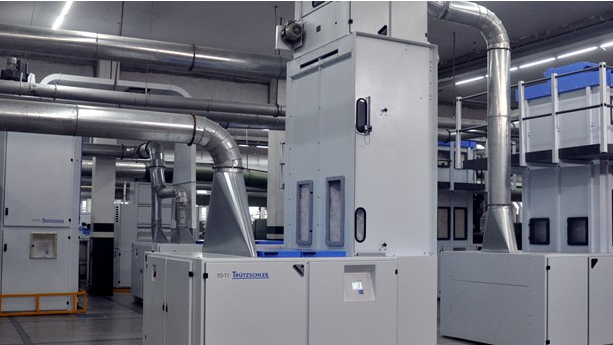Indian Textiles Industry Gears Up For A Quantum Leap
The Indian textiles industry is set to get a fillip with the Indian government pitching Textiles India as the next big thing to generate employment, ramp up manufacturing and boost exports. The scale in terms of participation at the just-concluded Textiles India 2017 at Gandhinagar in Gujarat was matched by the presence of senior functionaries of the government, leading one to conclude that Indian textiles would be the government’s trump card for Make in India.
The event was not only inaugurated by Prime Minister Narendra Modi himself, besides having the conspicuous presence of Union textiles minister Smriti Irani and her minister of state Ashok Tamta, the active involvement of a number of other ministers was clearly indicative of the fact that the government is looking at inter-ministerial efforts in order to boost the textiles and apparel industry.
The Prime Minister marked the direction that the event was to take on the inaugural day on June 30 when he called upon foreign delegates to “come, invest and make textiles in India.” He said, “The textiles industry has a pivotal position in the Indian economy. It is strong and competitive across the value chain. India has an abundant supply of raw material like cotton, wool, silk, jute, and man-made fibre. In fact, it is the world’s largest producer of cotton and jute, and second largest producer of silk and man-made fibre. This provides us the distinct advantage of backward integration, which many other countries may not have. In addition, India has strong spinning, weaving, knitting and apparel manufacturing capacities. Young, skilled labour is available at a reasonable cost.”
Vice-chairman of Niti Ayog Arvind Panagariya on the concluding day on July 2 marvelled at the scale of the event, and described it as one of the largest of its kind to be held anywhere in the world. He spoke about the 65 memoranda of understanding that were signed with countries like South Korea, Bangladesh and Russia, among others. Panagariya noted that the Chinese visitors were remarkably impressed with the Textiles India 2017 event, and went on to add that the apparel industry had a huge potential to create jobs. He described these as “good” jobs, and such jobs could be created in the apparel industry with significantly less investment compared to other industries.
In all, 65 MoUs were inked between various domestic and international organisations from industry and government during the event. Three of these were G2G deals, and the MoUs related to exchange of information and documentation, research & development, commercialisation of handloom products and silk production, cooperation in geotextiles, skill development, supply of cotton and trade promotion with overseas partners, etc. Addressing newspersons after the deals had been signed, Smriti Irani said that the ongoing developments (particularly during Textiles India 2017) signalled a golden era for the country’s textile industry. She reassured industry about the commitment of the government of India in promoting the sector.
Irani also spoke about how eyebrows were raised when the event was first conceived, and asserted that its success and overwhelming participation from industry showed that not only had it not been a wrong idea in the first place, the subsequent editions of Textiles India would only scale up. Both Irani and others who spoke at the valedictory session indicated that there was competition among states wanting to hold it next year.
The textiles minister also contended that the diversity of the Indian textiles segment lay in the co-existence of cotton and man-made fibres (MMF). She insisted that MMF was not at war with Indian cotton. Union minister for chemicals and fertilisers Ananth Kumar, who engaged with the MMF industry earlier in the day, admitted that he never knew that the seeds of the textiles industry lay in the petrochemicals ministry. Kumar had said that the two ministries should have more of such conversations so that the government can work holistically.
Similar sentiments were echoed by Union minister for agriculture Radha Mohan Singh, who described natural fibres as the backbone of the Indian textiles industry. Singh noted that despite stiff competition from synthetic fibres, the demand for natural fibres was steadily increasing with a growing population. Natural fibre production involved millions of farmers and industries using them are creating rural jobs, he said.
Chairing a session on ‘Productivity and Product Diversification Challenges for Natural Fibres’, he said that given the bottlenecks in increasing the area under cultivation, the only way to improve production would be to increase productivity. Introduction of high-yielding varieties, best agronomical practices, efficient fibre extractors and effective utilisation for diversified products will improve productivity. This is the right time for all stakeholders to discuss and formulate a suitable strategy to increase productivity of all natural fibres.
Sharing her thoughts as the chair of a session on making India a sourcing hub and investment destination for the world, Union minister for commerce and industry, Nirmala Sitharaman recounted the historical fact that the Indian textiles sector had attained global prominence long before many other sectors could establish themselves. Noting that India itself was a very big market, Sitharaman insisted that the industry needed to tap opportunities in both domestic as well as international markets.
The session on skilling was chaired by the Union minister for skill development and entrepreneurship, Rajiv Pratap Rudy. He pointed out that Skill India was an integral part of both Make in India and Textiles India, and argued that a key question facing the skill sector was that of creating a basic first-level skilling ecosystem in the country. Citing examples of various beneficiaries, he highlighted the need for short-term skilling programmes, and formal interventions for skilled manpower. He said that work was being done in this direction by his ministry, to address the questions of how, for whom, where, curriculum, content, examination, certification and employment as it related to skilling requirements of the countr

Leave a Reply
You must be logged in to post a comment.